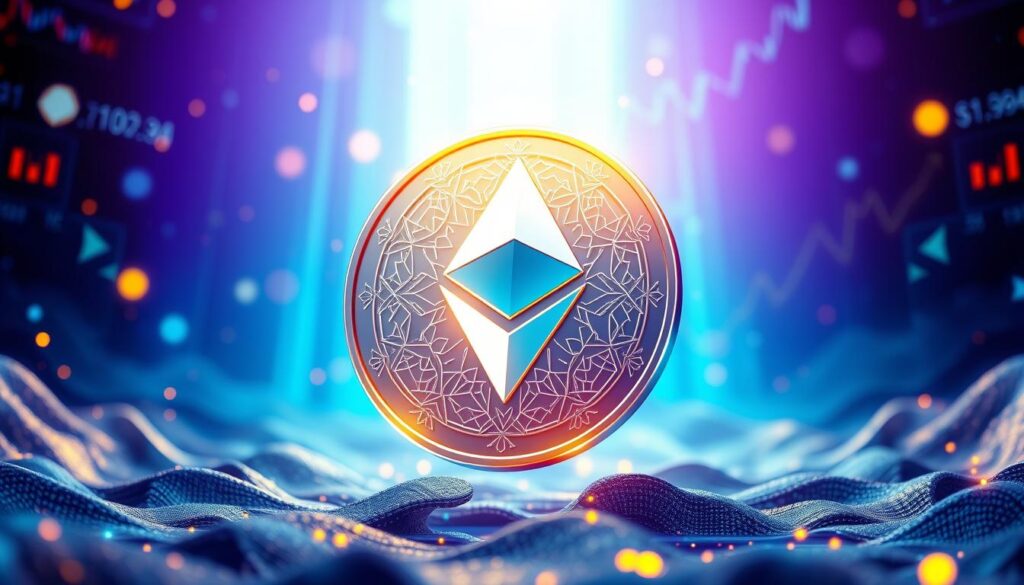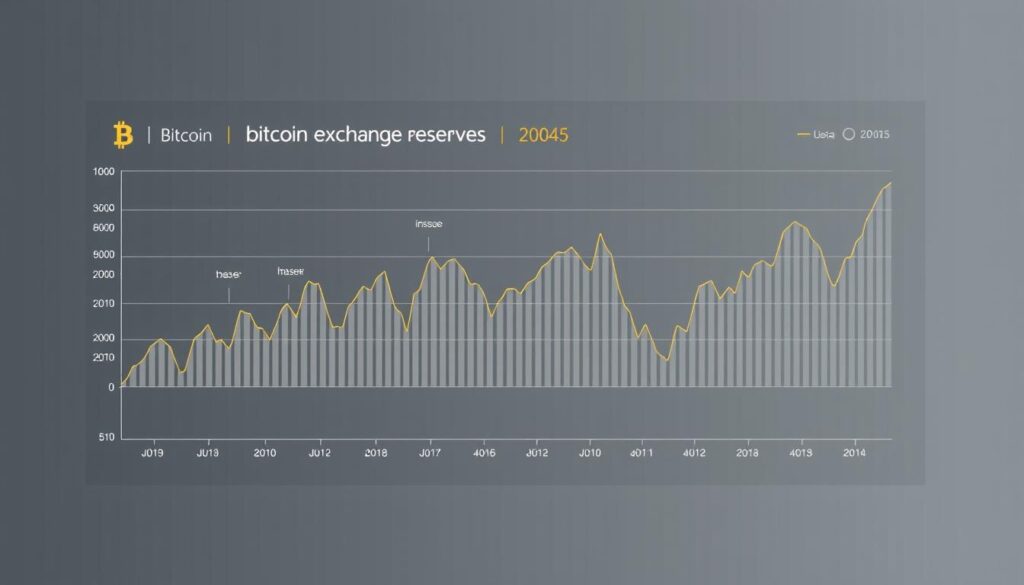Now Reading: Ethereum (ETH): Revolutionizing Digital Finance
- 01
Ethereum (ETH): Revolutionizing Digital Finance
Ethereum (ETH): Revolutionizing Digital Finance

Ethereum, the revolutionary blockchain platform, has emerged as a transformative force in the digital finance landscape. Powered by cutting-edge technology, Ethereum enables the creation of smart contracts and decentralized applications (dApps), paving the way for a new era of decentralized finance (DeFi) and innovative solutions. As a leading cryptocurrency, Ethereum (ETH) has become a cornerstone of the blockchain ecosystem, offering users a secure and transparent platform for a wide range of financial transactions and digital services.
Key Takeaways
- Ethereum is a revolutionary blockchain platform that has transformed the digital finance industry.
- Ethereum enables the creation of smart contracts and decentralized applications (dApps), driving the growth of decentralized finance (DeFi).
- Ethereum’s Ethereum Virtual Machine (EVM) provides a robust infrastructure for executing smart contracts and powering innovative solutions.
- Ethereum’s native cryptocurrency, Ether (ETH), has become a prominent digital asset in the blockchain ecosystem.
- The Ethereum network’s transition to a Proof-of-Stake consensus mechanism aims to enhance scalability and sustainability.
Introduction to Ethereum
Ethereum, the pioneering blockchain technology, has revolutionized the way we perceive and interact with digital finance. As the second-largest cryptocurrency by market capitalization after Bitcoin, Ethereum has been at the forefront of the decentralized finance (DeFi) revolution, transforming the traditional financial landscape.
What is Ethereum?
Ethereum is an open-source, decentralized blockchain platform that enables the development and execution of smart contracts and distributed applications (dApps). Unlike Bitcoin, which is primarily a digital currency, Ethereum is a versatile platform that allows developers to build and deploy a wide range of decentralized applications, from decentralized exchanges to decentralized lending platforms.
The Concept of Decentralized Finance
Decentralized finance, or DeFi, is an ecosystem of financial applications built on blockchain technology, particularly the Ethereum network. DeFi aims to provide an alternative to traditional centralized financial institutions, offering a more transparent, inclusive, and accessible financial system. Key features of DeFi include:
- Permissionless access: Anyone with an internet connection can participate in DeFi applications without the need for intermediaries or gatekeepers.
- Decentralized control: DeFi applications are powered by smart contracts, eliminating the need for centralized authorities to manage and control financial transactions.
- Transparency: The underlying blockchain technology provides a transparent and immutable record of all transactions, promoting trust and accountability.
- Interoperability: DeFi applications can seamlessly interact with each other, enabling the creation of complex financial products and services.
By leveraging the power of Ethereum’s blockchain technology, DeFi is transforming the way we think about finance, making it more accessible, transparent, and inclusive for individuals and businesses alike.
“Ethereum is a technology that’s not just a lousy cryptocurrency, but actually a revolution in computer science, in finance, in the concept of trust and governance.”
– Vitalik Buterin, Co-founder of Ethereum
Ethereum (ETH): The Revolutionary Cryptocurrency
Ethereum, the second-largest cryptocurrency after Bitcoin, has emerged as a revolutionary force in the digital finance landscape. Ether, the native token of the Ethereum network, serves as the fuel that powers the entire Ethereum ecosystem, enabling seamless transactions, executing smart contracts, and fueling the decentralized applications (dApps) built on the platform.
The Ethereum network is built upon blockchain technology, a decentralized, distributed digital ledger that records transactions securely and transparently. Unlike traditional financial systems, Ethereum operates without a centralized authority, allowing users to interact directly with the network and engage in a wide range of financial activities, from lending and borrowing to trading and investing.
- Ether: The Versatile Cryptocurrency
- Ether is used to pay for transaction fees and computational power required to execute smart contracts on the Ethereum network.
- It also serves as a medium of exchange, allowing users to buy, sell, and trade digital assets and services within the Ethereum ecosystem.
- Powering the Ethereum Ecosystem
- Ether is the lifeblood of the Ethereum network, enabling the development and deployment of decentralized applications (dApps) that revolutionize various industries, from finance to gaming.
- These dApps leverage the power of smart contracts, which are self-executing agreements that automatically enforce the terms of a contract, without the need for intermediaries.
- Revolutionizing Digital Finance
- Ethereum’s blockchain-based platform provides a secure and transparent infrastructure for peer-to-peer transactions, eliminating the need for centralized financial institutions.
- This decentralized approach has the potential to increase financial inclusion, reduce transaction costs, and empower individuals and businesses to take control of their financial futures.
The Ethereum network and its native cryptocurrency, Ether, have the potential to reshape the digital finance landscape, offering a more equitable, transparent, and accessible financial system for people around the world.
“Ethereum has the potential to become the backbone of the new internet-based economy.” – Vitalik Buterin, Ethereum co-founder
Smart Contracts: The Foundation of Ethereum
At the heart of the Ethereum network lies a groundbreaking technology known as smart contracts. These self-executing digital agreements, written in the Solidity programming language, are transforming the way we interact and conduct transactions in the digital world.
Understanding Smart Contracts
Smart contracts are essentially computer programs that automatically execute the terms of an agreement between parties. They operate on the Ethereum blockchain, leveraging the network’s decentralized infrastructure to ensure transparency, security, and tamper-resistance.
Benefits of Smart Contracts
The advantages of smart contracts are numerous:
- Automated Execution: Smart contracts eliminate the need for intermediaries, streamlining transactions and reducing the risk of human error.
- Transparency: The terms of a smart contract are publicly visible and verifiable, promoting trust and accountability.
- Tamper-Resistance: Once a smart contract is deployed, its code cannot be altered, ensuring the integrity of the agreement.
- Programmability: Smart contracts can be programmed to handle complex, conditional logic, enabling the development of decentralized applications (dApps) on the Ethereum (ETH) platform.
By harnessing the power of smart contracts, the Ethereum network has become a hub for innovative decentralized applications that span various industries, from finance and supply chain management to gaming and social media.
“Smart contracts are the foundation of the Ethereum network, empowering developers to create a new generation of decentralized applications that challenge traditional centralized models.”
Decentralized Applications (dApps) on the Ethereum Network
The Ethereum network has become a hub for innovative decentralized applications (dApps) that leverage the power of smart contracts and blockchain technology. These dApps span a wide range of industries, from decentralized finance (DeFi) protocols to gaming platforms and beyond, showcasing the versatility of the Ethereum ecosystem.
Developers on the Ethereum network can create dApps that address a variety of use cases, taking advantage of the platform’s smart contract capabilities. These dApps offer users secure, transparent, and tamper-resistant solutions, without the need for centralized intermediaries.
Some of the prominent categories of Ethereum-based dApps include:
- DeFi protocols that facilitate lending, borrowing, trading, and other financial services in a decentralized manner
- Decentralized exchanges that enable peer-to-peer trading of Ethereum-based tokens and cryptocurrencies
- Blockchain-based gaming platforms that offer unique in-game economies and player-owned assets
- Decentralized social media and content platforms that empower users with greater control over their data and content
The growth of Ethereum-based dApps has been fueled by the network’s strong developer community, robust infrastructure, and the increasing mainstream adoption of blockchain technology. As the Ethereum ecosystem continues to evolve, the potential for more innovative and impactful dApps to emerge remains promising.
| Decentralized Application (dApp) | Description | Ethereum-based Functionality |
|---|---|---|
| Uniswap | A decentralized exchange protocol for trading Ethereum-based tokens | Utilizes Ethereum smart contracts to facilitate automated, peer-to-peer token swaps |
| Compound | A decentralized lending and borrowing platform for Ethereum-based assets | Leverages Ethereum smart contracts to enable users to lend, borrow, and earn interest on their digital assets |
| Axie Infinity | A blockchain-based game where players can collect, breed, and battle digital creatures called Axies | Built on the Ethereum network, allowing players to own and trade their in-game assets as Ethereum-based non-fungible tokens (NFTs) |

“The Ethereum network has become a thriving ecosystem for decentralized applications, showcasing the transformative potential of blockchain technology.”
The Ethereum Virtual Machine (EVM)
At the heart of the Ethereum network lies the Ethereum Virtual Machine (EVM), a decentralized environment that plays a crucial role in executing smart contracts. The EVM is responsible for processing and verifying transactions on the Ethereum blockchain technology, ensuring consistency and security across all nodes.
Executing Smart Contracts on the EVM
The EVM utilizes a set of instructions, known as EVM instructions, to enable the seamless execution of smart contracts. These smart contracts are self-executing pieces of code that define the rules and conditions for various transactions and interactions within the Ethereum network. The EVM’s ability to consistently interpret and execute these smart contracts is what makes the Ethereum platform so powerful and versatile.
By leveraging the EVM, developers can create decentralized applications (dApps) that operate on the Ethereum network, harnessing the power of smart contracts to automate complex processes and streamline financial transactions. This decentralized approach to application development offers enhanced security, transparency, and efficiency, paving the way for a new era of Ethereum (ETH)-based digital finance.
| Key Features of the Ethereum Virtual Machine (EVM) | Description |
|---|---|
| Decentralized Execution | The EVM ensures that smart contracts are executed consistently and securely across all Ethereum nodes, promoting transparency and trust. |
| Gas Metering | The EVM uses “gas” as a unit of computational effort, ensuring efficient resource allocation and preventing abuse of the network. |
| State Management | The EVM maintains a state machine that keeps track of the current state of the Ethereum network, enabling the seamless execution of smart contracts. |
The Ethereum Virtual Machine is a cornerstone of the Ethereum (ETH) ecosystem, empowering developers to create innovative decentralized applications that leverage the power of smart contracts and the Ethereum blockchain technology.
Gas Fees: The Lifeblood of the Ethereum Network
At the heart of the Ethereum (ETH) network lies the concept of gas fees, the essential transaction fees paid by users to execute actions on the blockchain. These gas fees serve as the lifeblood that powers the Ethereum ecosystem, enabling the seamless operation of blockchain transactions and the thriving decentralized applications (dApps) built upon the network.
The gas fees on Ethereum play a crucial role in maintaining the network’s security and stability. They incentivize miners to validate and process transactions, ensuring the integrity of the Ethereum blockchain. The fees vary based on network congestion, with higher demand typically resulting in increased gas prices to prioritize transactions.
To optimize the Ethereum network’s scalability and accessibility, developers are continuously exploring solutions to reduce gas fees and enhance the user experience. Advancements in layer-2 scaling technologies, such as rollups and sidechains, aim to offload transaction processing from the main Ethereum chain, thereby lowering the gas costs for users.
As the Ethereum ecosystem evolves, the management of gas fees remains a critical challenge. Balancing the need for affordable transactions with the network’s security and stability is crucial for the long-term success of the platform. Ongoing research and development in this area will determine Ethereum’s ability to scale and accommodate the growing demand for its blockchain transactions and decentralized applications (dApps).
Proof-of-Work vs. Proof-of-Stake: Ethereum’s Journey
Ethereum, the second-largest blockchain network after Bitcoin, has embarked on a transformative journey by transitioning from the Proof-of-Work (PoW) consensus mechanism to the Proof-of-Stake (PoS). This shift, known as the Ethereum 2.0 upgrade, aims to address the scalability, energy efficiency, and sustainability challenges associated with the original PoW approach.
The key difference between PoW and PoS lies in the way transactions are validated and new blocks are added to the blockchain. In a PoW system, miners compete to solve complex mathematical puzzles, requiring significant computational power and energy consumption. On the other hand, PoS relies on network validators, who stake their Ethereum (ETH) tokens to participate in the consensus process, making the system more energy-efficient and accessible to a wider range of users.
- Scalability: The PoS model in Ethereum 2.0 is designed to improve the network’s scalability, enabling it to handle more transactions per second compared to the PoW approach.
- Energy Efficiency: By transitioning to PoS, Ethereum is expected to reduce its energy consumption significantly, aligning with the growing global focus on sustainable blockchain solutions.
- Inclusivity: PoS allows more users to participate in the network as validators, lowering the barriers to entry and fostering a more inclusive ecosystem.
While the transition to PoS presents its own set of challenges, such as the potential for centralization and the need for robust security measures, Ethereum’s move is widely seen as a strategic step towards a more sustainable and scalable future for the blockchain industry.
“The transition to Proof-of-Stake is a critical milestone in Ethereum’s journey, positioning the network as a more energy-efficient and inclusive platform for decentralized applications and digital finance.”
As Ethereum continues to evolve, the shift to PoS is expected to unlock new opportunities for users, developers, and the broader blockchain ecosystem, ultimately contributing to the network’s long-term viability and growth.
Ether: The Native Currency of Ethereum
Ether (ETH) is the native cryptocurrency of the Ethereum network, a revolutionary cryptocurrency platform that has transformed the world of decentralized finance (DeFi). Ether plays a crucial role in powering transactions, executing smart contracts, and fueling the thriving ecosystem of decentralized applications (dApps) built on the Ethereum blockchain.
As the lifeblood of the Ethereum network, Ether is used to pay for computational resources required to run and maintain the network. It is the primary means of exchange for a wide range of DeFi services, including lending, borrowing, trading, and yield farming. The growing adoption of Ether in the DeFi space has made it an increasingly valuable digital asset, with investors and enthusiasts alike recognizing its potential as a transformative force in the world of finance.
- Ether (ETH) is the native cryptocurrency of the Ethereum network.
- It powers transactions, executes smart contracts, and fuels the Ethereum ecosystem.
- Ether is the primary means of exchange for a variety of DeFi services.
- The increasing adoption of Ether in DeFi has made it a valuable digital asset.
Ethereum (ETH) and its native currency, Ether, have revolutionized the world of decentralized finance, enabling a new era of innovation and financial empowerment.

As the Ethereum network continues to evolve and expand, the role of Ether as the driving force behind its success is only expected to grow. Investors and users alike are recognizing the transformative potential of this groundbreaking cryptocurrency, which is poised to shape the future of the digital economy.
Conclusion
Ethereum (ETH) has undoubtedly emerged as a revolutionary force in the world of digital finance. Its blockchain technology, smart contracts, and decentralized applications (dApps) have transformed the way we approach transactions, finance, and technological innovation. By leveraging the power of decentralization, Ethereum is paving the way for a more secure, transparent, and inclusive financial ecosystem.
The Ethereum network’s ability to enable decentralized finance (DeFi) has opened up a world of possibilities, allowing individuals and businesses to engage in a wide range of financial activities without the need for traditional intermediaries. Smart contracts, a core component of the Ethereum platform, have revolutionized the way we execute and enforce agreements, offering increased efficiency, reliability, and transparency.
As the Ethereum ecosystem continues to evolve, with the transition to a Proof-of-Stake consensus mechanism and the growing adoption of decentralized applications, the potential for Ethereum to disrupt and reshape the global financial landscape is truly remarkable. This technology holds the promise of a more democratic, accessible, and innovative digital future, where the power of finance and technology is decentralized and empowers individuals and communities alike.
FAQ
What is Ethereum?
Ethereum is a revolutionary blockchain platform that enables the creation of smart contracts and decentralized applications (dApps). It is powered by the Ethereum Virtual Machine (EVM) and has transformed the digital finance landscape.
What are smart contracts?
Smart contracts are self-executing agreements written in code that run on the Ethereum blockchain. They automate the execution of agreements between parties, providing transparency, security, and tamper-resistance.
What are decentralized applications (dApps)?
Decentralized applications (dApps) are applications built on the Ethereum blockchain that leverage smart contracts to provide a wide range of services, from decentralized finance (DeFi) protocols to gaming platforms and beyond.
How does the Ethereum Virtual Machine (EVM) work?
The Ethereum Virtual Machine (EVM) is the core component of the Ethereum network responsible for executing smart contracts. It processes and verifies transactions, enabling the seamless execution of decentralized applications (dApps) on the Ethereum platform.
What are gas fees, and why are they important?
Gas fees are the transaction fees paid by users to execute actions on the Ethereum network. They are the lifeblood of the Ethereum network, powering the execution of smart contracts and decentralized applications (dApps). The factors influencing gas prices and ongoing efforts to optimize gas usage are crucial for the accessibility and scalability of the Ethereum ecosystem.
What is the difference between Proof-of-Work (PoW) and Proof-of-Stake (PoS)?
Ethereum’s original consensus mechanism was Proof-of-Work (PoW), but it is transitioning to a Proof-of-Stake (PoS) model. PoS aims to improve the network’s scalability, energy efficiency, and sustainability, addressing some of the challenges associated with the PoW approach.
What is Ether (ETH), and what is its role?
Ether (ETH) is the native cryptocurrency of the Ethereum network. It is used to power transactions, execute smart contracts, and fuel the decentralized applications (dApps) built on the Ethereum platform. Ether’s growing role in the decentralized finance (DeFi) ecosystem also highlights its potential as a valuable digital asset.
















